The Bay Trail Preview: Intel Atom Z3770 Tested
by Anand Lal Shimpi & Brian Klug on September 11, 2013 12:00 PM ESTIn addition to showing Bay Trail running on a Windows 8.x platform, Intel showed us a “pre-beta” version of the platform running Android 4.2.2. I have to emphasize that the build they showed us definitely seemed pre-beta, as there was some instability, but overall the build was good enough to run some tests on and get a feel for. Intel made it clear that they do have a lot more work to do on their Android build before it’s considered close to final quality than the Windows equivalent.
Inside Android we can still see the CPU state table data and how long the cores are sitting in each performance state still, despite this now being managed in-silicon on Bay Trail. In addition Android sees the 2.39 GHz Z3770 boost frequency and reports it. I didn’t see any strange behavior on the device while running tests and watching CPU frequency, if anything the reference design platform stayed at the maximum boost frequency even with four cores plugged in for an impressive amount of time. Of course this is a tablet so there’s more TDP to play around with compared to a phone.
Depending on where you were in the Android UI, there was some definite stutter, but I’m told this is a result of an issue with Dalvik not allocating threads to cores properly that Intel is still tuning, something which you can see plays itself out as well in the AndEBench Java test that runs in Dalvik. The launcher especially had some stutter, but Intel claimed they were aware of it and that final performance in areas like that would be dramatically improved. Regardless of the state of Bay Trail’s Android port, it affords us the opportunity to look at performance through our pretty standard benchmark suite.
On the CPU side for Android we’re still limited to just a few tests that rely on a combination of native code and stuff that runs inside the browser. That means AndEBench, JavaScript benchmarks, and part of Vellamo.
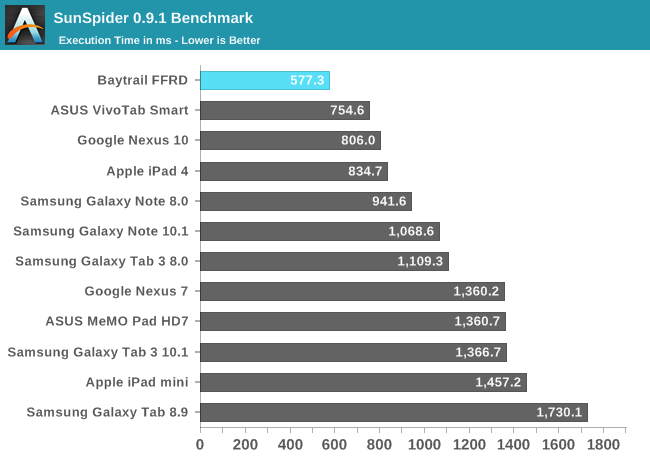
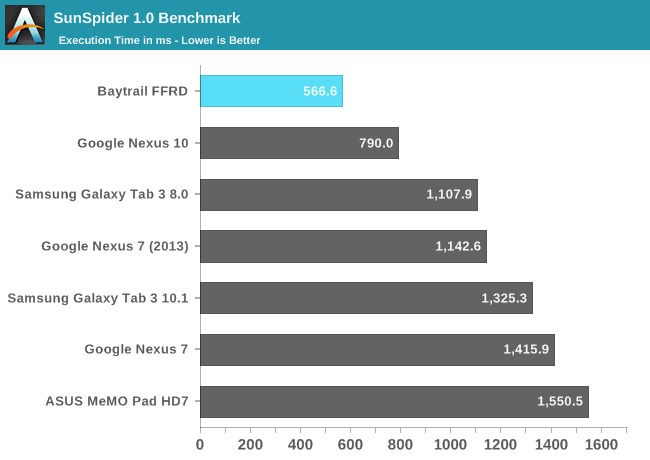
Sunspider has been a regular staple but in recent time has become an exercise in browser JavaScript engine optimization rather than actual performance. Nevertheless the FFRD takes the crown in both 1.0 and 0.9.1 (we have more tablet data from the 0.9.1 version so I replicated it here).
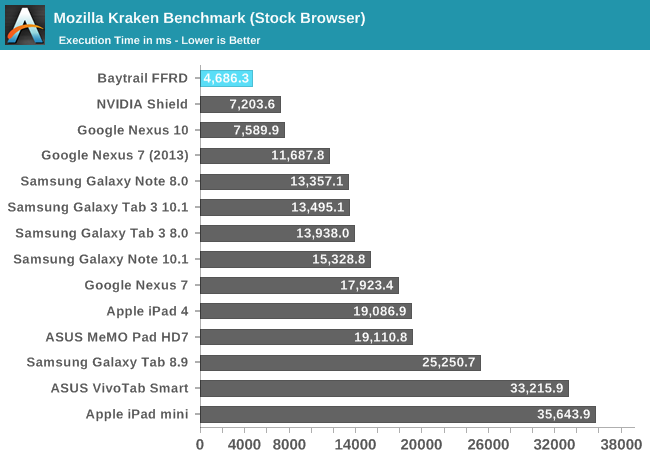
Kraken is another JavaScript benchmark which hasn’t quite been an optimization target everyone has gone after lately, and it’s also longer, which makes it a bit more reliable. Once again Bay Trail takes the crown here with notably faster JS engine performance.
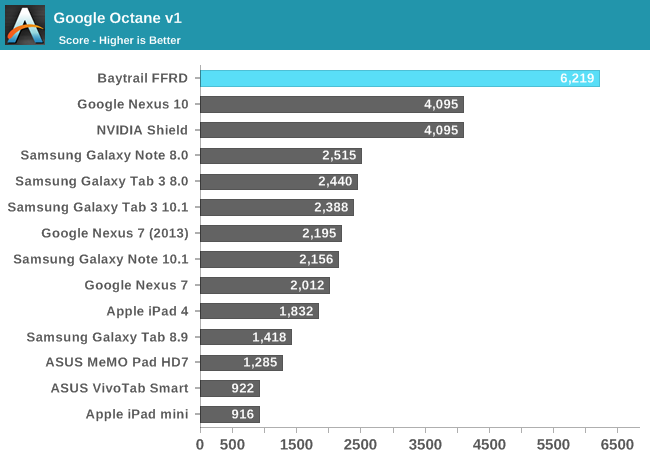
Google Octane is another JS test that isn’t quite as platform optimized yet, here there’s once again dominance by Bay Trail with just over a 50 percent higher score.
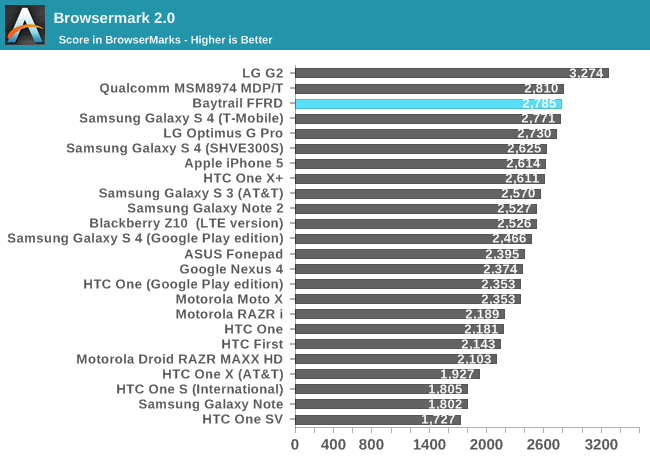
Browsermark has a combination of both JS tests and other web related performance metrics. Here the Bay Trail platform lags behind the 8974 based devices slightly. This isn’t a raw JavaScript benchmark again but rather a more holistic web browsing performance test, so it’s interesting to see Bay Trail a bit behind here.
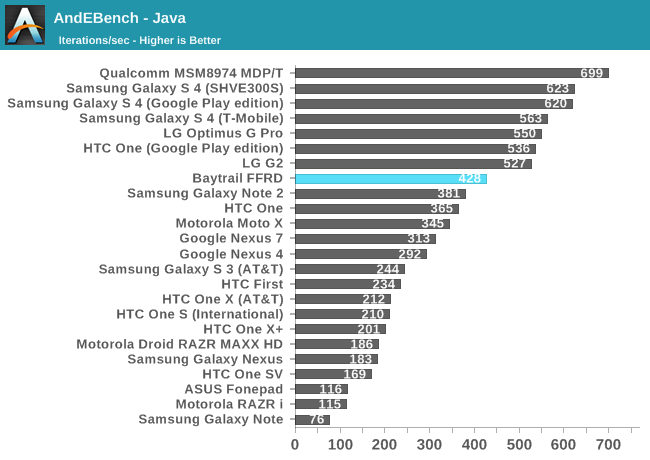

AndEBench is a combination native compiled microkernel benchmark (indicative of NDK application performance) that also runs a very similar workload atop Dalvik like a normal Android Java application. Here we can see what Intel was talking about when they said they have more work to do getting Dalvik working properly at dispatching threads to appropriate cores, hopefully the Java number will climb considerably. The native test also shows a lead over the competition.
GPU Performance
While Bay Trail clearly leads on the CPU side, its GPU performance is more middle of the road - at least among the higher end SoCs. In 3DMark Bay Trail's GPU performance is aided by the more CPU bound nature of the benchmark, but here Intel is able to beat the Snapdragon 600. Snapdragon 800 on the other hand pulls ahead by around 35%.
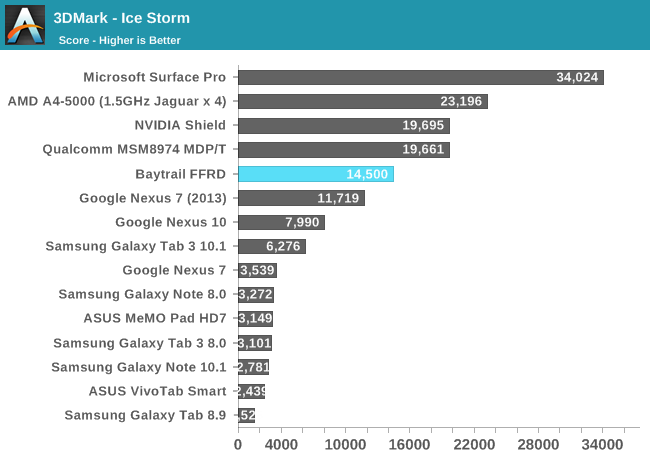
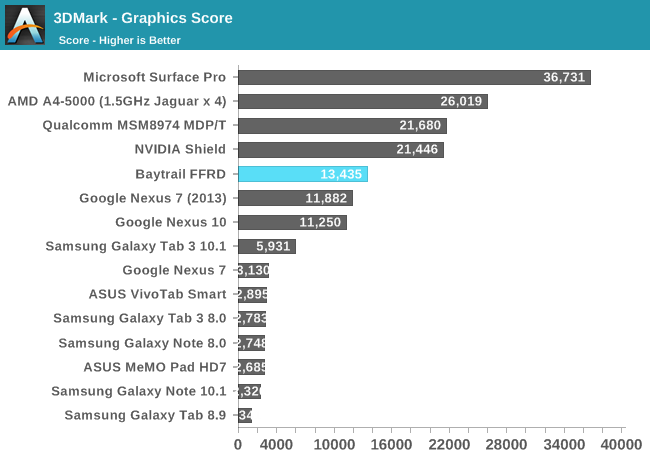
The 3DMark Physics test is effectively a CPU test, which once again plays to Bay Trail's strengths. Here it's faster than Snapdragon 800 and Cortex A15. Only Ivy Bridge is quicker in a tablet.
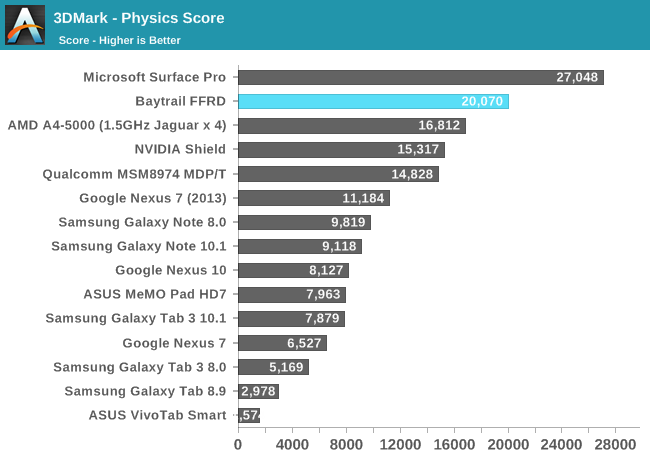
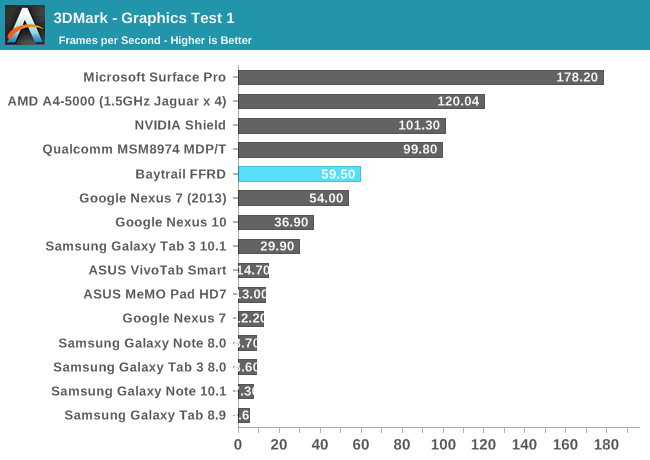
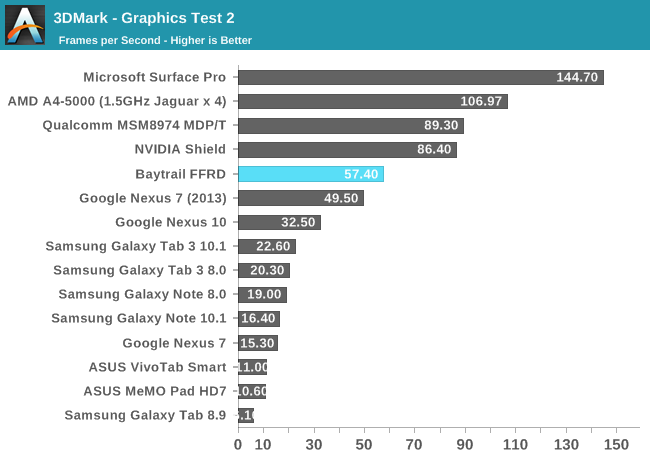
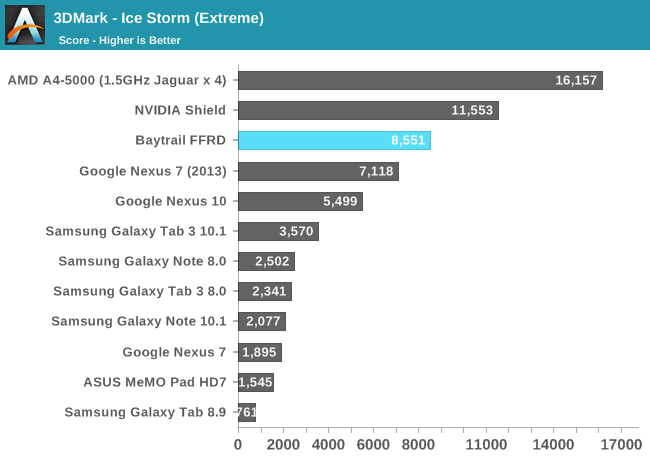
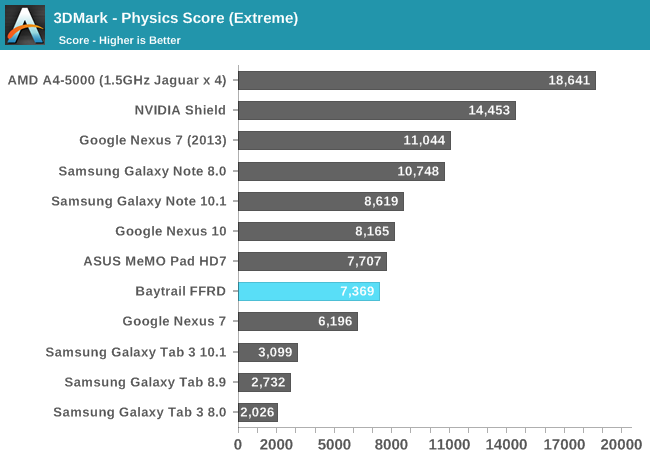
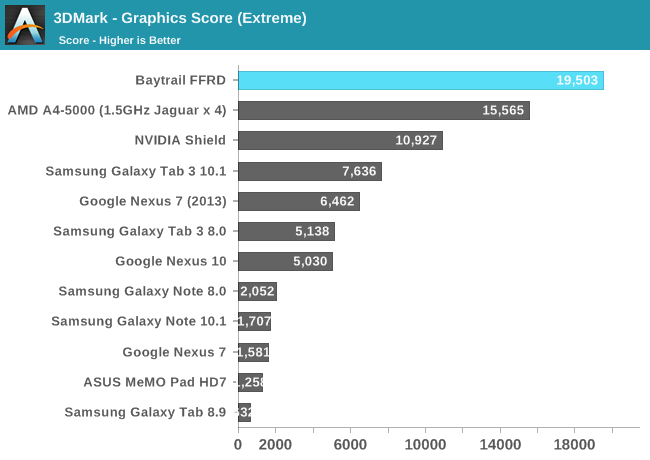
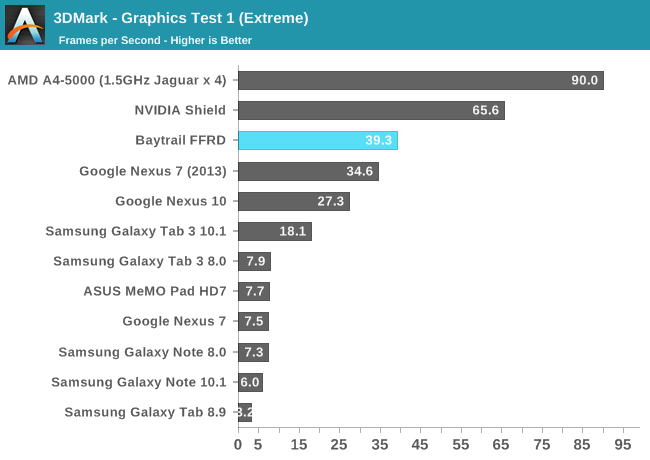
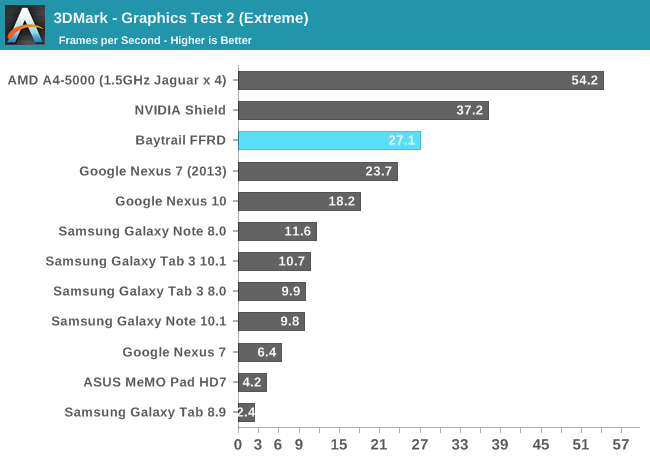
Basemark X
Basemark X is a bit more GPU bound than 3DMark, and we also have iOS data here so we can put Bay Trail's performance in better perspective. Here Bay Trail is a bit slower than the iPad 4, and clearly Tegra 4 and Snapdragon 800. Intel's GPU in Android is measurably quicker than Adreno 320/S600 though.
Bay Trail's onscreen performance is penalized by the FFRD's extremely high native resolution.

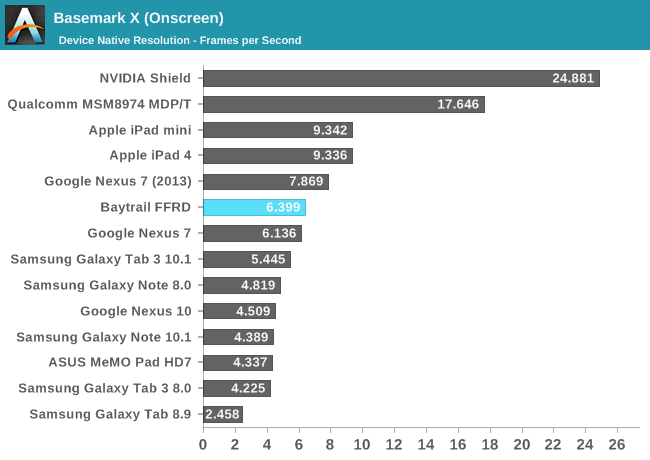
GLBenchmark 2.7
The more interested GLBenchmark numbers, T-Rex HD, show Bay Trail just behind the iPad 4 in performance. It's definitely not bad at all but clearly not industry leading.
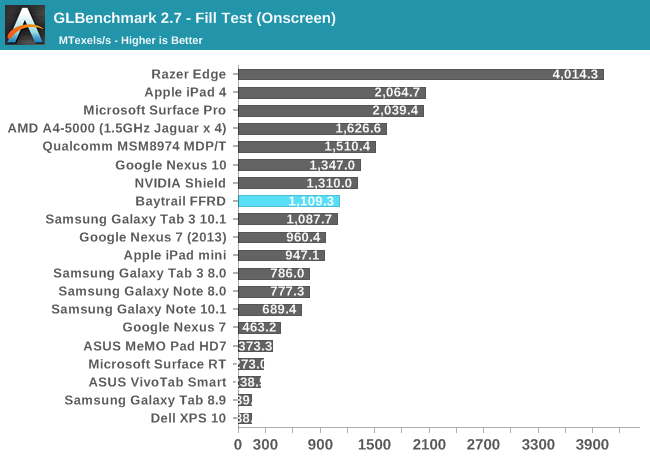
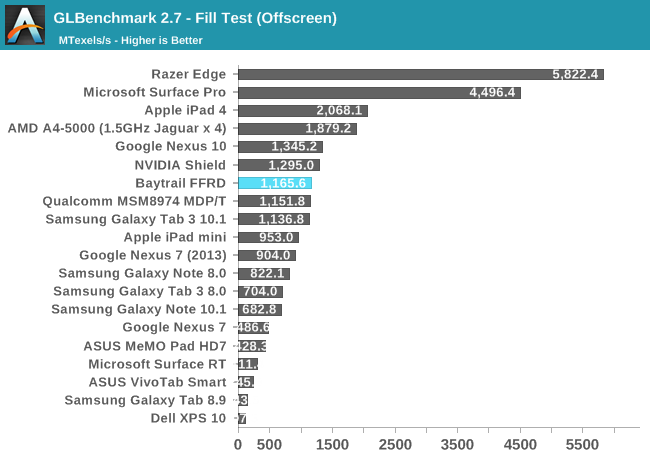
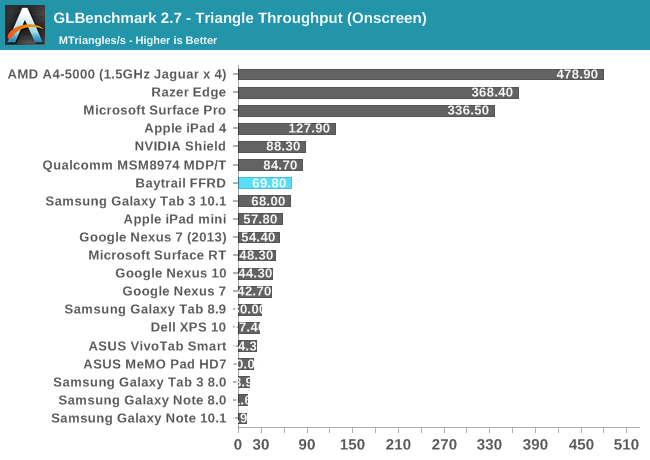
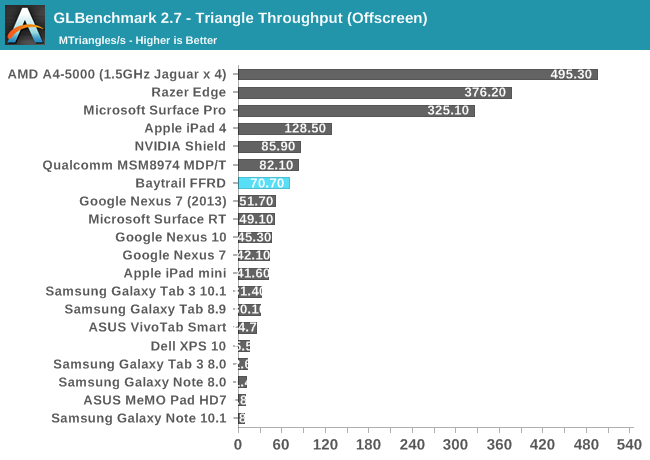
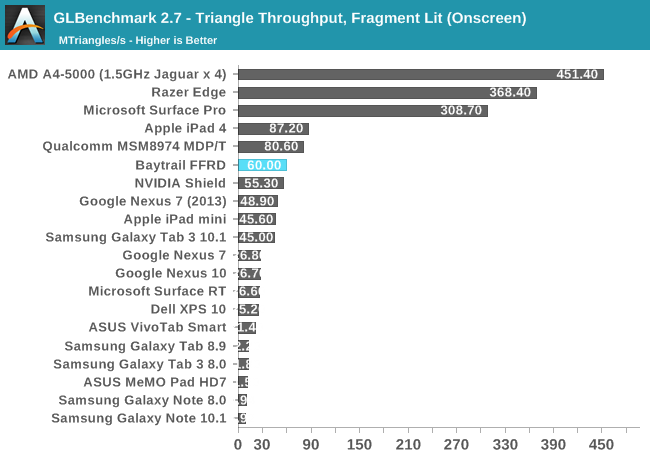
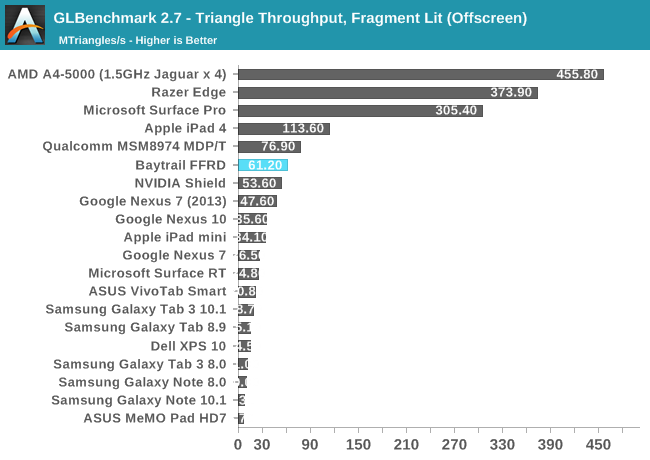
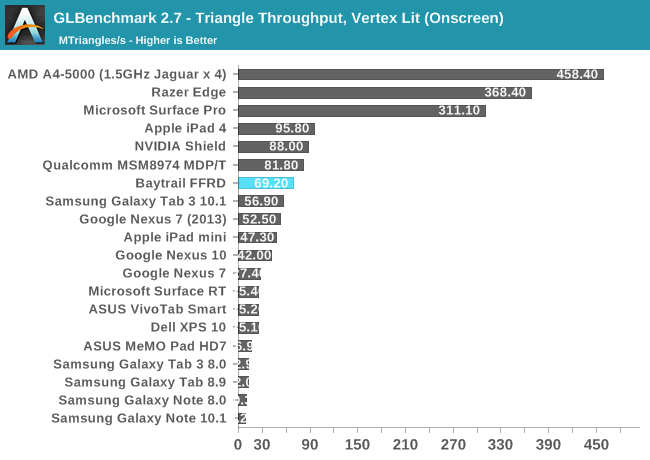
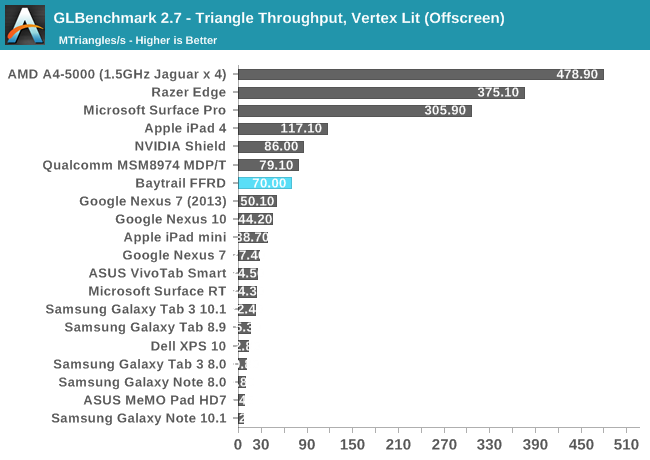
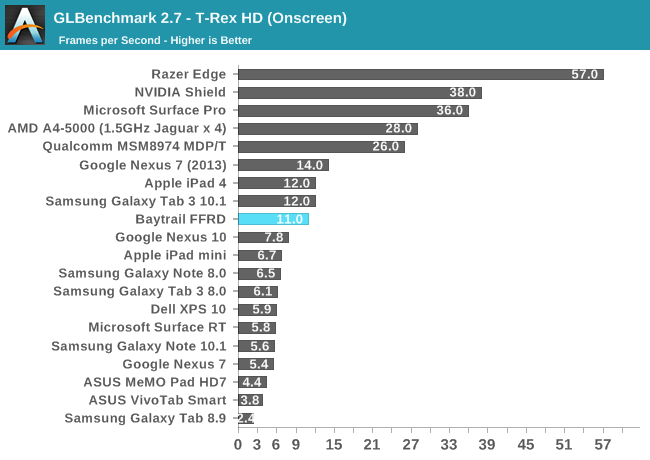
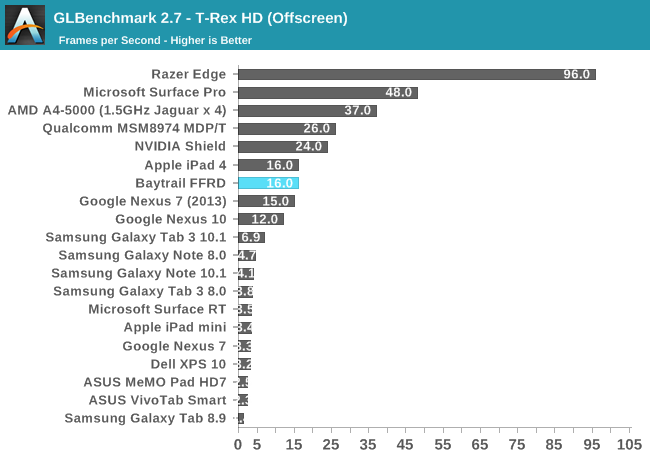
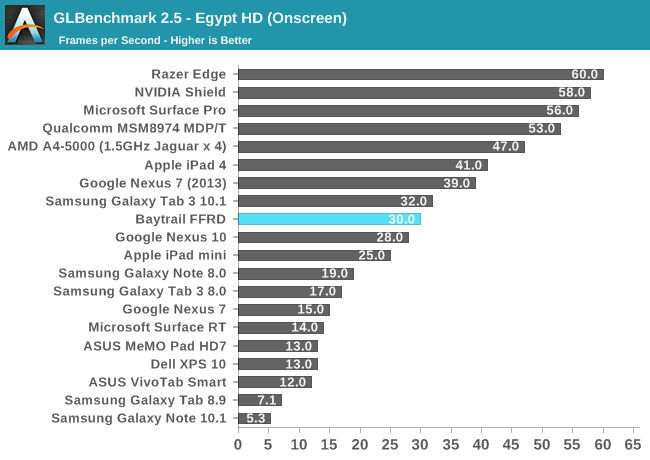
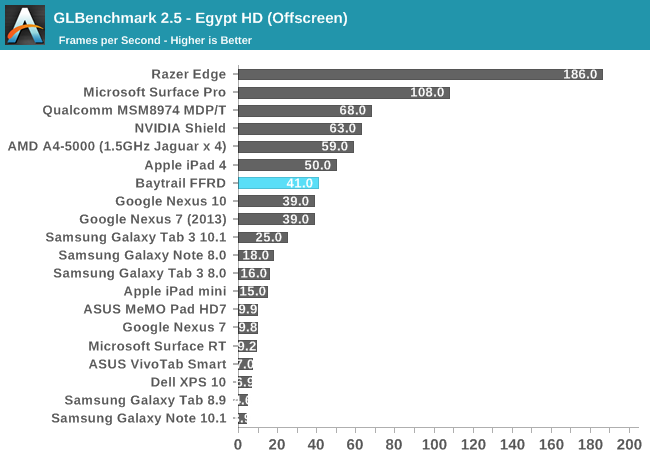
















190 Comments
View All Comments
jfinely - Wednesday, September 11, 2013 - link
In the graphics the S800 is ahead but on the cpu side Baytrail dominates.So when you look at the SoC as a whole, it is too close to call.
The difference maker could be the energy consumption
Baytrail should run less energy consumption
phoenix_rizzen - Monday, September 16, 2013 - link
Really? Have you seen the battery use benchmarks Anandtech has done on the S800 in a phone form-factor? If not, go read through some of them. The S800 SoC doubles, sometimes triples, the S4Pro and S600 SoC battery life. And that's in a phone! Add in the extra thermal headroom of a tablet, along with the larger battery of a tablet, and I fail to see how Bay Trail can compete.zeo - Thursday, September 19, 2013 - link
The SD800 is limited in a phone and not running at the full possible performance and so is using a lot less power than it would in a tablet! Not to mention the smaller, typically around 720P screen on the phone versus 1080P on the tablet also tends to reduce power consumption for the phone...Really, the Clover Trail was already shown by Anandtech to be more energy efficient than many Cortex A9 ARM SoCs like the Tegra 3. While Bay Trail improves that power efficiency by about 5x!
Even while providing over twice the performance of Clover Trail and with double the number of cores, the Bay Trail still only uses about the same or less power than Clover Trail.
Besides, the phone optimized Merrifield for ATOM isn't out yet... So you're comparing the phone optimized SD800 to the tablet optimized Bay Trail T!
The Nokia Sirius 10" Tablet was going to be released with a SD800 and only claimed up to 10 hours run time! Bay Trail 10" tablet like the upcoming Asus T100 on the other hand claim up to 11 hours, albeit with a lower resolution screen!
While Anandtech showed extremely good performance per watt for Bay Trail in this review...
So at the very least they're very competitive on power efficiency and it's not a issue as you suggested!
Nagorak - Wednesday, September 11, 2013 - link
Well, you know, even if that were true, the point would be it's made by Intel and not Qualcomm. Intel doesn't get money from Snapdragon CPU sales, hence their interest in making their own CPU.In terms of CPU performance, it looks to me like Intel has really delivered here, but the graphics performance is still holding them back. Still it's hard to say Snapdragon smokes the new Atom. At worst they trade wins depending on whether it's CPU or GPU.
jasonelmore - Thursday, September 12, 2013 - link
i lol'd thankszeo - Wednesday, September 11, 2013 - link
Six months? Both Toshiba and Dell already announced 8" Bay Trail Tablets that will be released by the end of October of this year!Asus also announced a T100 2 in 1 tablet with keyboard dock... And you can't run the full range of software on a ARM SoC, but Intel can run any flavor of Windows, Android, Linux, or even OSX... They're also scaling up to higher end versions with even more performance that'll be low cost alternatives to Haswell...
fteoath64 - Thursday, September 12, 2013 - link
Same impression I got. For Intel to spend another 2 years to retool Atom to this stage yet, outgunned by both S800 and Tegra4 is really a POOR showing for the king of CPUs!. Many have said, just lay Atom to rest and continue with Haswell core "slash n burn" to cut down on power consumption and replace the pathetic MediaHD gpu with a variant of Rouge6 from Imagineering. Just as what Apple has done. The fact that Intel kept wanting to retain x86 compatibility shows, its constraints to out-do Arm in this low power game. Even on 22nm process the results are way LESS than passing grade (I would give 45% mark which is a FAIL still). Marginal but fail no doubt!. This chip should have been out 3 years ago and things might not have looked this bad. I guess Intel going with Quark might spur something useful. But I doubt it as Arm M3 is a mighty little thing just as hard to crack as the Cortex brothers .... Nice try Intel but fail still. Sorry.tech4real - Thursday, September 12, 2013 - link
if you read the results carefully, you can clearly see this atom's CPU muscle is stronger than S800.As for Tegra4 in Shield, please remember it's a fan device(meaning the power budget is >5W, a lot higher than this baytrail device), which makes the performance comparison unfair. Even then, some reviews find that baytrail trades blows with shield. To me, it shows significant perf/W advantage for silvermont core against both krait and A15.
you can find more benchmark results at:
http://techreport.com/review/25329/intel-atom-z300...
http://www.pcper.com/reviews/Processors/Intel-Atom...
monstercameron - Friday, September 13, 2013 - link
this tested baytrail platform was an intel prototype, so comparing it to a shipping product is a bit skewed, also tegra 4 can be passively cooled, it is just that it needs active cooling to keep its performance stable in the shield formfactor. Note that the tegra 4 has a better gpu than baytrail [higher performance higher power] which might be adding to the overall power draw.tech4real - Friday, September 13, 2013 - link
i agree on the point it's an intel prototype, so to be fair we need to wait till next month to really try on a shipping baytrail-T product. But as for tegra 4, my sources are saying even with CPU only heavy load(to remove the GPU effect), its power dissipation is still too high. Thus makes tegra4 pretty weak in terms of perf/W.I am sure we will get the clear picture next month as they come out.